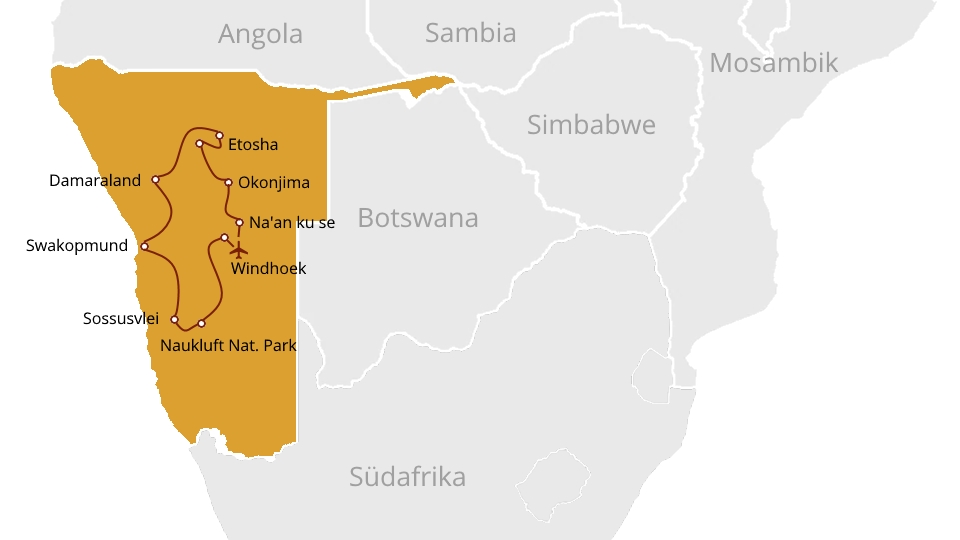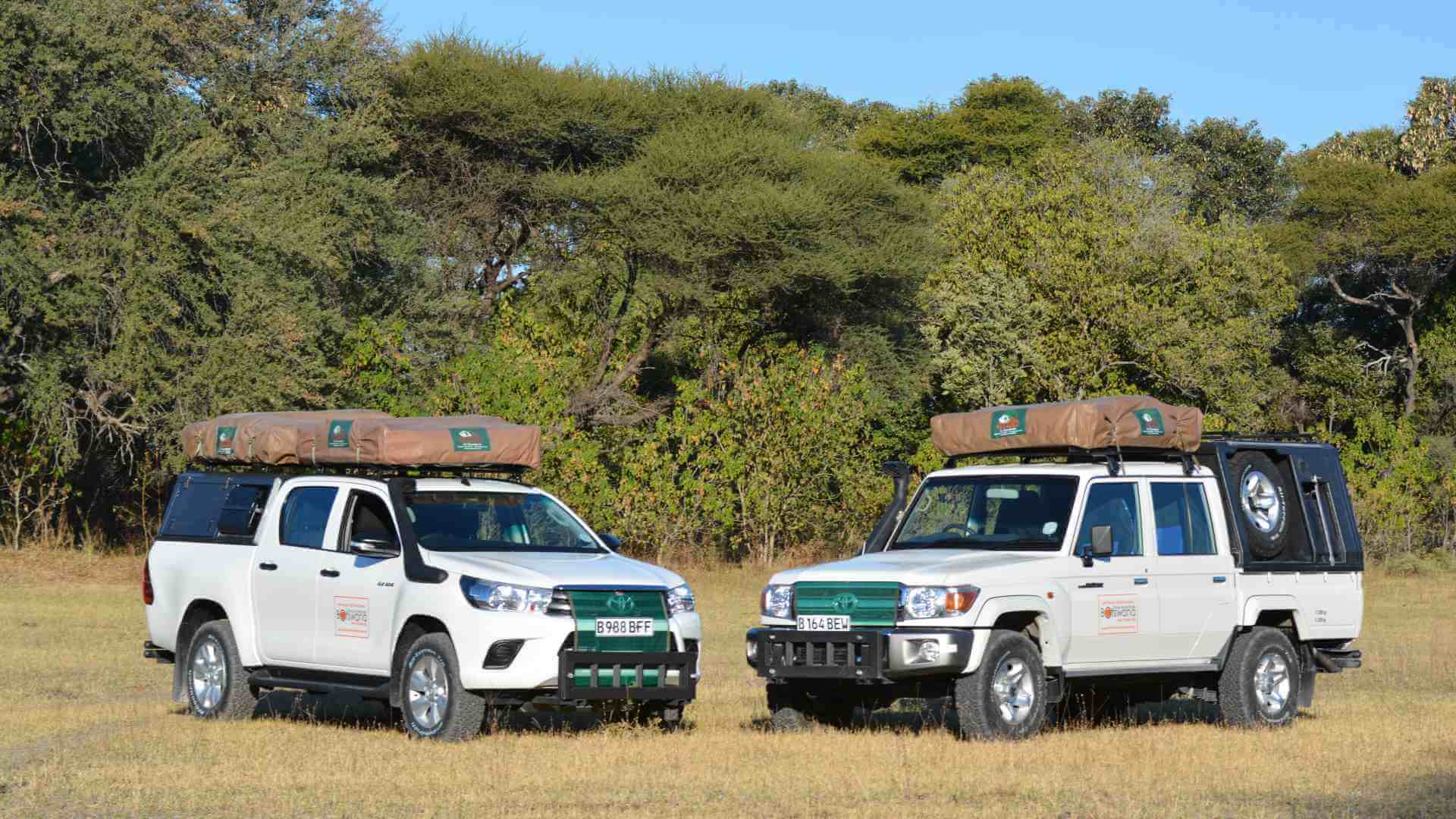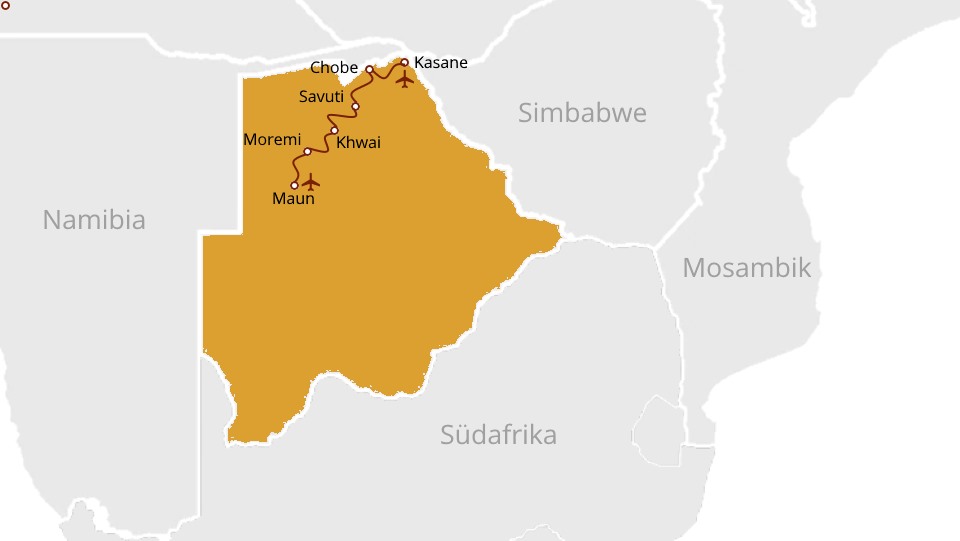Day 1: Greater Windhoek
Airport - Windhoek (approx. 42 km/0:30 h)
After arriving at the airport in Windhoek, you will be greeted by an employee from our agency. You will then be driven to the car rental station, where your booked camper is already waiting for you. Here you will be thoroughly briefed on the vehicle, shown how to set up and drive back in the roof tents, where which camping equipment is and everything else that is important.
If necessary, you can visit Windhoek's numerous and well-stocked supermarkets and buy food, drinks and everything else you need for your upcoming adventure.
Your destination today is Na an ku se Lodge. For the first time, this is pure African safari feeling. Here you can choose from a wide range of activities that focus on animal welfare and conservation. The Carnivore Feeding Tour is particularly recommended, during which you can visit the big cats living on the grounds and get up close and personal as they feed.
Day 2: Okonjima Nature Reserve
Windhoek - Okonjima Nature Reserve (approx. 226 km/2:33 h)
After breakfast, we head north. On the well-developed national road, you drive through vast countryside with numerous farms to the left and right of the road. Not only are there cattle here, you will also often encounter antelopes, giraffes, zebras, warthogs and much more here. Here, too, they are committed to nature conservation and take care of animals that have come into conflict with farmers outside. Ideally, they are abandoned in a huge game reserve and can lead normal lives. In particular, this concerns leopards and cheetahs, which can often be spotted in their natural environment as part of game drives. In addition to big cats, you will of course also find lots of other animals that are native to this part of Africa.
Day 3: Otjiwarongo
Okonjima Nature Reserve - Waterberg Region (approx. 114 km/1:32 h)
This morning, there is an opportunity to take part in morning activities in the Nature Reserve. The trip then takes you across the pretty town of Otjiwarongo, which still looks very German in many places today.
The Waterberg region is already heavily influenced by wild African nature. There are many animals here that you would only expect to find in national parks. The mountains themselves have a permanent supply of water, which makes them so important for the arid region.
Day 4: Etosha South
Waterberg Region - Etosha South (approx. 185 km/1:55 h)
This morning, there is an opportunity to take part in your accommodation's activities. During the day, head towards Etosha National Park. In Otjiwarongo or Outjo, you should stock up on your supplies for the days ahead of you in the National Park.
If you've passed through Outjo, it gets really lonely. Only very rarely do you get other cars here. Your current accommodation is close to Anderson Gate. There is time to relax in your lodge before heading to the actual park tomorrow morning.
Day 5: Etosha East
Etosha South - Etosha National Park (approx. 120 km/1:51 h)
You should set off early in the morning to start the safari adventure. Once you've passed Anderson Gate, your first stop is the Okaukuejo Base Camp, where you should complete the necessary formalities. On the way here, however, you have certainly been able to see quite a few animals.
The rest of the day is dedicated to the breathtaking wildlife of Etosha. With your off-road vehicle, you can now drive to the numerous water points, which are very often home to a plethora of animals.
However, you shouldn't head to camp too late so that you still have enough time to set up your (roof) tents.
Day 6: Etosha East
Etosha National Park
It's time to get up very early today! At sunrise, the national park gates open and you drive your off-road vehicle to go hunting. There is a lot going on here at this time, the nocturnal animals return, the diurnal animals come out of hiding. In the light of the rising sun, the bush shines in wonderful light, a paradise for photographers! Whether you are traveling all day or spending the heat of the day in your camp is up to you.
There is actually always something to see, thirsty animals also come to the lodge's own watering hole, colorful birds drink in the pool, and small antelopes roam around the accommodation and enjoy the safety of being close to people.
Day 7: Etosha East
Etosha National Park
A safari routine is established. In the first morning light, it goes out into the wild, whether into the thick bush away from the large salt pan, or directly to the edge of the huge flat plain, which is usually dry there. Depending on the amount of rainfall and time, however, the largest number of animals gather here to drink at one of the few water points.
Day 8: Etosha West
Etosha National Park - Etosha West (approx. 243 km/4:05 h)
In the morning, you will finally drop out of camp and head west through the national park. This is a relatively new part of the national park, which used to be virtually inaccessible as a restricted area. The landscape has changed significantly; lush, hilly landscape prevails here. Local wild animals can be observed particularly well at the numerous water points.
Day 9: Twyfelfontein
Etosha West - Twyfelfontein (approx. 297 km/4:20 h)
In the morning, leave the park and head towards Damaraland. There is a lot to see along the way. The landscape here is dry and lonely. But even here, there is plenty of animal life. With a bit of luck, you can see the famous desert elephants. But various living museums, i.e. villages in which the people living here show their way of life, a petrified forest, and much more invite you to stop by. In the afternoon, you will arrive at camp for tonight. Here, surrounded by large red rocks in the midst of breathtaking nature, you will experience a magical night.
Day 10: Twyfelfontein
Twyfelfontein
It's time to explore the wonderful area. In addition to the well-known World Heritage Site of Twyfelfontain, Damaraland offers many other sights. Twyfelfontain is considered one of the richest rock art galleries in all of Africa. At the Burnt Mountain National Monument, you can marvel at an intense variety of colors in the volcanic rock and the nearby dolomite columns of the Organ Pipes are strongly reminiscent of organ pipes.
Day 11: Swakopmund
Twyfelfontein - Swakopmund (approx. 324 km/4:14 h)
On the way to the coast, you will pass through the wonderful landscapes of Damaraland. There is exciting things to discover everywhere on the left and right. On the way, a stop at the Spitzkoppe, the Matterhorn of Africa, is worthwhile. The red rocks rise steeply out of the plain and can be seen from afar. It is a wonderful place to hike and climb. You will then drive to Swakopmund, the most German city in Africa. Here you can still see many relics of the German colonial period from over a hundred years ago. German is still spoken everywhere here.
Day 12: Swakopmund
Swakopmund
Enjoy your time in Swakopmund to enjoy the fresh sea air, look out at the ocean and relax. Swakopmund also has a lot to offer in terms of cuisine: You can eat excellent fish everywhere, which is not common in Namibia. Why not rent a few big bikes and cycle with them through the dunes and along the beach? A great experience!
Day 13: Swakopmund
Swakopmund
Another day on the coast, perfect for trips and exploration. We recommend taking a boat trip to see dolphins and seals. You can book a variety of offers and, if you feel like it, you can also take a close look at the animals with canoes. Alternatively, you can also go on guided expeditions into the desert and marvel at the astonishingly diverse life in this rugged nature. Or how about a skydive? There is so much to do in Swakopmund.
Day 14: Sesriem
Swakopmund - Sossusvlei (approx. 347 km/4:33 h)
You leave the coast and turn into the desert at Walvisbay. For the next 100 km, you think you're in the Sahara. Sand as far as the eye can see. But soon the landscape will be mountainous and overall it will be greener again. But it remains lonely and only a few farms lie left and right by the sea. Along the way, you'll pass Solitaire, a small collection of buildings and a gas station. A good place for lunch before heading on to one of Namibia's most famous sights: The red dunes near Sesriem with the Sossusvleij. The images of a majestic oryx antelope in front of the deep red dunes are world-famous. Today and/or tomorrow, you have the opportunity to see it with your own eyes. Depending on your personal preferences, you can go on an afternoon tour today or go to sunrise tomorrow morning. And maybe you'll still find time for the Sesriem Canyon?
Day 15: Sesriem
Sossusvlei
You should set off at the first opportunity and head towards the big red dunes. In the morning light, these majestic sandy mountains glow in a magical light. Since the temperatures are still bearable, you can set out to climb them. The view is breathtaking.
Other options today would be to visit the Sesriem Canyon, a deep gorge that you can hike through. And the Naukluft Zebra Mountain Park is also not far away and could be the destination of a trip.
Day 16: Off
Sossusvlei - Off (approx. 345 km/4:50 h)
From Sesriem, it goes further and further south. You drive through the Namib Rand Nature Reserve: sandy and gravel plains and savanna sections alternate with mountain ranges, island mountains and green dune belts. Your destination today is the region around the small town of Aus, which is located on the disused railway line to Lüderitz in a magical desert and mountain world.
Day 17: Off
Off
The arid landscape in this area is known for its unique botanical diversity. Aus is an excellent starting point for exploring the area and seeing the main attraction: the wild horses of the Namib Desert running wild and free on the sparsely planted plains. Hiking through the beautiful countryside with its fascinating local flora and fauna is also a possible highlight.
Day 18: Fish River Canyon
Off - Fish River Canyon (approx. 281 km/3:10 h)
The journey takes you east through the barren but beautiful countryside to one of the continent's greatest natural wonders. The Fish River Canyon is the largest canyon in Africa with a length of about 160 km, a width of up to 27 km and a depth of up to 550 m. It is considered the second largest in the world after the Grand Canyon in the USA.
Day 19: Fish River Canyon
Fish River Canyon
Today, you have the opportunity to take in the dramatic nature all day long. From numerous viewpoints, there are always views of the gorge. The most famous is undoubtedly the one at Hells Bend, the Hell Curve. We can only advise against descending to the riverbed, it can get very hot here and the descents are very steep. But you can also discover a lot at the top. The wildlife population has recovered very well and with a bit of luck you can see mountain zebras, springboks, ostriches, giraffes, oryx antelopes, cow antelopes and kudus here.
Day 20: Mariental
Fish River Canyon - Mariental (approx. 401 km/4:22 h)
From Fish River Canyon, it's now heading north again. You'll pass Keetmanshoop, a small town with much evidence of German colonial history. There is a remarkable quiver tree forest in the surrounding area and a variety of bizarre rock formations in the Giants Playground. Marienthal, your destination for the night, is the capital of the region and supplies the surrounding communities and farms. The Hardap Reservoir, which enables irrigated agriculture in the region, is in the immediate vicinity.
Day 21: Windhoek
Mariental - Central Namibia (approx. 312 km/3:34 h)
We continue north to the capital Windhoek. Here, too, you can still feel a great deal of influence from German colonial heritage. A city tour takes you right past most sights.
Day 22: End of trip
Windhoek - airport
After check-out, depending on the booked program or departure time, you still have some time to buy the last souvenirs or stroll through Windhoek's streets again.
You will then drive back to the car rental company and drop off your vehicle. An employee will then drive you to the airport.





























































































